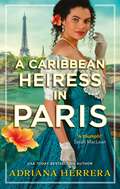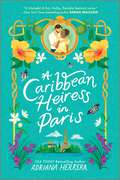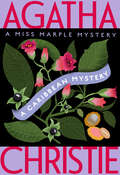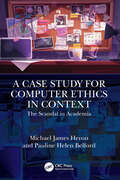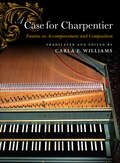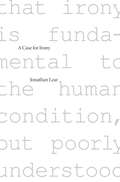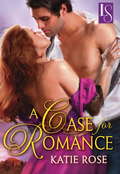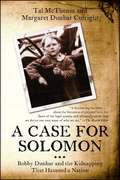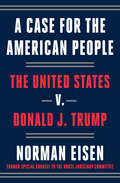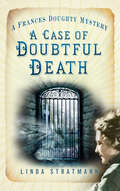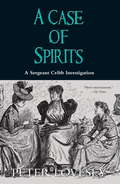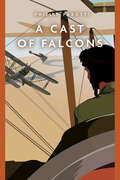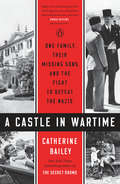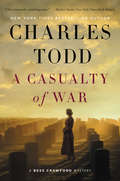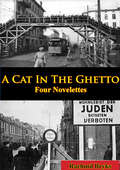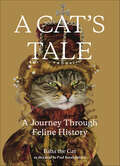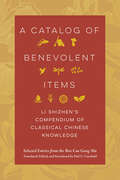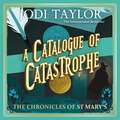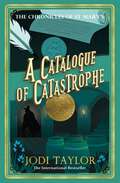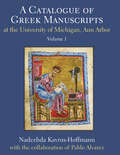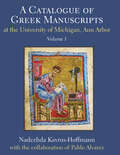- Table View
- List View
A Career in Radio: Understanding the Key Building Blocks
by Sayed Mohammad AmirThis book gives an overview of the development, significance, and impact of radio as a medium of mass communication in modern society. It provides a thorough understanding of the various wings and functionaries of the radio industry. The book also covers aspects of commercial radio, the basics of understanding the pulse of radio listeners, formatting radio programming, making an effective sales pitch and producing great commercials to exhaustive advice on presenting a show, appearing for interviews, and public speaking. It also gives insight into the changes brought in by technology in terms of traditional radio broadcasts, such as digital radio, highlighting its advancements in audio quality and the diversity of programming options available, and satellite radio, subscription-based services, and exclusive access to specialised programming. An outcome of the author’s vast experience of working as a radio jockey and programme manager for over 17 years, his book will be an ideal textbook for undergraduate and postgraduate students of journalism and mass communication, taking courses on radio, audio and podcasting, media production and digital media. Additionally, this book will be an invaluable companion to existing radio professionals as a resource-book for their professional development.
A Caribbean Heiress in Paris
by Adriana Herrera'A Caribbean Heiress in Paris is a triumph!' Sarah MacLean'Historical romance at its very best - fresh, lush and full of steam!' Sophie JordanParis, 1889. Luz Alana Heith-Benzan, heiress to the Caña Brava rum empire, has sailed all the way from Santo Domingo with one purpose: expanding her family's business.Enter James Evanston Sinclair, Earl of Darnick. From their first tempestuous meeting, Luz Alana is conflicted - why is this titled, and infuriatingly charming, Scottish man so willing to help her?Evan might have his own reasons for supporting Luz Alana but every day they spend together makes him yearn for more of her. And with Luz Alana's inheritance dependent on her being married, a marriage of convenience might be the perfect solution.But when Luz Alana set sail to Paris, she came armed with three hundred casks of rum, her two best friends and one simple rule: under no circumstances is she to fall in love . . .Why readers love A Caribbean Heiress in Paris . . . 'Ferociously feminist and sensual, with a dreamily diverse cast. A Caribbean Heiress in Paris is a dazzling historical romance' Helen Hoang'A breath of fresh air featuring everything I love about historical romance' Martha Waters, author of To Love and to Loathe'A lush, vivid romance, highly recommended' Evie Dunmore'A pure delight from start to finish . . . this peek into the glittering world of the Belle Époque will leave you breathless' Joanna Shupe'Lush settings, rich characters, and that familiar feeling of West Indies's allure will steal your heart' Vanessa Riley'An enchanting and unforgettable story' Chanel Cleeton'This book has everything you could want in historical romance' Harper St. George'The historical romance of my dreams' Eva Leigh
A Caribbean Heiress in Paris: A Historical Romance (Las Leonas #1)
by Adriana Herrera"A romp-filled and refreshingly diverse historical romance."—BuzzfeedParis, 1889The Exposition Universelle is underway, drawing merchants from every corner of the globe…including Luz Alana Heith-Benzan, heiress to the Caña Brava rum empire.Luz Alana set sail from Santo Domingo armed with three hundred casks of rum, her two best friends and one simple rule: under no circumstances is she to fall in love. In the City of Lights, she intends to expand the rum business her family built over three generations, but buyers and shippers alike can&’t imagine doing business with a woman…never mind a woman of color. This, paired with being denied access to her inheritance unless she marries, leaves the heiress in a very precarious position.Enter James Evanston Sinclair, Earl of Darnick, who has spent a decade looking for purpose outside of his father&’s dirty money and dirtier dealings. Ignoring his title, he&’s built a whisky brand that&’s his biggest—and only—passion. That is, until he&’s confronted with a Spanish-speaking force of nature who turns his life upside down.From their first tempestuous meeting, Luz Alana is conflicted. Why is this titled—and infuriatingly charming—Scottish man so determined to help her?For Evan, every day with Luz Alana makes him yearn for more than her ardent kisses or the marriage of convenience that might save them both. But Luz Alana sailed for Paris prepared to build her business and her future; what she wasn&’t prepared for was love finding her."Herrera excels at propelling the romance genre and its form forward, and this book is no exception... Herrera is crafting swoony historical romances that aren't afraid to engage with the realities of the 19th-century while still making a bid for hard-earned happily-ever-afters."—Entertainment Weekly Can't get enough of the Las Leonas? Book 1: A Caribbean Heiress in Paris Book 2: An Island Princess Starts a Scandal Book 3: A Tropical Rebel Gets the Duke
A Caribbean Mystery: A Miss Marple Mystery (Miss Marple Mysteries #10)
by Agatha ChristieAs Jane Marple sat basking in the tropical sunshine she felt mildly discontented with life. True, the warmth eased her rheumatism, but here in paradise nothing ever happened. Then a question was put to her by a stranger: 'Would you like to see a picture of a murderer?' Before she has a chance to answer, the man vanishes, only to be found dead the next day. The mysteries abound: Where is the picture? Why is the hotelier prone to nightmares? Why doesn't the most talked-about guest, a reclusive millionaire, ever leave his room? And why is Miss Marple herself fearful for her life? Of note: A Caribbean Mystery introduces the wealthy (and difficult) Mr Jason Rafiel, who will call upon Miss Marple for help in Nemesis (1971) -- after his death.
A Carnival of Revolution: Central Europe 1989
by Professor Padraic KenneyThis is the first history of the revolutions that toppled communism in Europe to look behind the scenes at the grassroots movements that made those revolutions happen. It looks for answers not in the salons of power brokers and famed intellectuals, not in decrepit economies--but in the whirlwind of activity that stirred so crucially, unstoppably, on the street. Melding his experience in Solidarity-era Poland with the sensibility of a historian, Padraic Kenney takes us into the hearts and minds of those revolutionaries across much of Central Europe who have since faded namelessly back into everyday life. This is a riveting story of musicians, artists, and guerrilla theater collectives subverting traditions and state power; a story of youthful social movements emerging in the 1980s in Poland, East Germany, Czechoslovakia, Hungary, and parts of Yugoslavia and the Soviet Union.Kenney argues that these movements were active well before glasnost. Some protested military or environmental policy. Others sought to revive national traditions or to help those at the margins of society. Many crossed forbidden borders to meet their counterparts in neighboring countries. They all conquered fear and apathy to bring people out into the streets. The result was a revolution unlike any other before: nonviolent, exuberant, even light-hearted, but also with a relentless political focus--a revolution that leapt from country to country in the exciting events of 1988 and 1989.A Carnival of Revolution resounds with the atmosphere of those turbulent years: the daring of new movements, the unpredictability of street demonstrations, and the hopes and regrets of the young participants. A vivid photo-essay complements engaging prose to fully capture the drama. Based on over two hundred interviews in twelve countries, and drawing on samizdat and other writings in six languages, this is among the most insightful and compelling accounts ever published of the historical milestone that ushered in our age.
A Case Study for Computer Ethics in Context: The Scandal in Academia
by Michael James Heron Pauline Helen BelfordAimed at addressing the difficulties associated with teaching often abstract elements of technical ethics, this book is an extended fictional case study into the complexities of technology and social structures in complex organizations. Within this case study, an accidental discovery reveals that the algorithms of Professor John Blackbriar are not quite what they were purported to be. Over the course of 14 newspaper articles, a nebula of professional malpractice and ethical compromise is revealed, ultimately destroying the career of a prominent, successful academic.The case study touches on many topics relevant to ethics and professional conduct in computer science, and on the social structures within which computer science functions. Themes range from the growing influence of generative AI to the difficulties in explaining complex technical processes to a general audience, also touching on the environmental consequences of blockchain technology and the disproportionate gender impacts of Coronavirus. Each new revelation in the case study unveils further layers of complexity and compromise, leading to new technical and social issues that need to be addressed.Directly aimed at making ethics in the digital age accessible through the use of real-world examples, this book appeals to computer science students at all levels of the educational system, as well as making an excellent accompaniment to lecturers and course convenors alike.
A Case for Charpentier: Treatise on Accompaniment and Composition (Historical Performance)
by Carla E. WilliamsWho originally authored the anonymous, undated French manuscript Traité d'accompagnement et de composition? Carla E. Williams tackles this mystery while providing the first English translation of this rare manuscript, which resides in the collections of the Lilly Library at Indiana University Bloomington. A Case for Charpentier presents a side-by-side transcription and translation of the treatise along with an introduction that offers historical context. In the manuscript itself, late 17th-century and early 18th-century writers discuss principal musical elements of composition including major and minor modes, the fundamental chords of both modes, dissonances and consonances, meter, tempo, and continuo realization, as well as basse continue. While these writers have not been formally identified, Williams argues that the handwriting of one is that of composer Marc-Antoine Charpentier. By providing a full physical description of the manuscript, along with comparisons of Charpentier's other writings and his handwriting, Williams sheds new light on both the treatise and Charpentier's theoretical writings. With this translation, Williams not only shares invaluable insights into the pedagogical approaches for composition and continuo realization in late 17th-century France but also finally makes Traité d'accompagnement et de composition available to a broader audience.
A Case for Irony (The Tanner lectures on human values #13)
by Jonathan LearIn 2001, Vanity Fair declared that the Age of Irony was over. Joan Didion has lamented that the United States in the era of Barack Obama has become an "irony-free zone." Jonathan Lear in his 2006 book Radical Hope looked into America’s heart to ask how might we dispose ourselves if we came to feel our way of life was coming to an end. Here, he mobilizes a squad of philosophers and a psychoanalyst to once again forge a radical way forward, by arguing that no genuinely human life is possible without irony. Becoming human should not be taken for granted, Lear writes. It is something we accomplish, something we get the hang of, and like Kierkegaard and Plato, Lear claims that irony is one of the essential tools we use to do this. For Lear and the participants in his Socratic dialogue, irony is not about being cool and detached like a player in a Woody Allen film. That, as Johannes Climacus, one of Kierkegaard’s pseudonymous authors, puts it, “is something only assistant professors assume.” Instead, it is a renewed commitment to living seriously, to experiencing every disruption that shakes us out of our habitual ways of tuning out of life, with all its vicissitudes. While many over the centuries have argued differently, Lear claims that our feelings and desires tend toward order, a structure that irony shakes us into seeing. Lear’s exchanges with his interlocutors strengthen his claims, while his experiences as a practicing psychoanalyst bring an emotionally gripping dimension to what is at stake—the psychic costs and benefits of living with irony.
A Case for Romance
by Katie RoseWith a delightful wit and a delicious talent for the unexpected, Katie Rose tells a sensuous tale of the wicked, wild West and the proper Bostonian there to solve a murder--only to become embroiled in romance. This isn't the fate Emily Potter imagined for her long-lost father: gunned down in cold blood in the parlor of his bordello in bawdy, booming Denver. Now the lovely armchair sleuth from the civilized East is determined to unmask the killer, employing the logic of her hero, Sherlock Holmes. Yet Holmes never faced distractions like the Reverend Thomas Hall, who seems unusually interested in the abandoned house of sin--and Emily's every move. Emily suspects the "preacher" knows more about gunslingers than the Good Book--and perhaps even something about her father's murder. All she knows is it's hard to keep her mind on deduction when Thomas seems intent on seduction. Meanwhile the bordello's matchmaking ghost insists on providing lessons in feminine wiles. But as logic gives way to passion, Emily forgets to protect both her vulnerable heart--and her life. Includes a special message from the editor, as well as excerpts from these Loveswept titles: All Is Fair . . ., Bad to the Bone, and Rescuing Diana.
A Case for Solomon: Bobby Dunbar and the Kidnapping That Haunted a Nation
by Margaret Dunbar Cutright Tal McTheniaThe spellbinding story of one of the most celebrated kidnapping cases in American history—the kidnapping of Bobby Dunbar—and a haunting family mystery that took almost a century to solve.THE MOST NOTORIOUS KIDNAPPING CASE IN AMERICAN HISTORY In 1912, four-year-old Bobby Dunbar went missing in the Louisiana swamps. After an eight-month search that electrified the country and destroyed Bobby’s parents, the boy was found, filthy and hardly recognizable. A wandering piano tuner was arrested and charged with kidnapping— a crime then punishable by death. But when a destitute single mother came forward from North Carolina to claim the boy as her son, not the lost Bobby Dunbar, the case became a high-pitched battle over custody—and identity—that divided the South. A gripping historical mystery, A Case for Solomon chronicles the epic century-long effort to unravel the startling truth.
A Case for the American People: The United States v. Donald J. Trump
by Norman EisenThe Democrats&’ special impeachment counsel on the House Judiciary Committee lays out President Trump&’s shocking pattern of betrayals, lies, and high crimes, arguing articles of impeachment to the ultimate judges: the American people. In his behind-the-scenes account of the attempts to bring the president to justice—from filing the very first legal actions against him, through the Mueller report, to the turbulent impeachment and trial, to the president&’s ongoing wrongdoing today—Norman Eisen, at the forefront of the battle since the day of Trump&’s inauguration, pulls back the curtain on the process. He reveals ten proposed articles of impeachment, not just the two that were publicly tried, all of which he had a hand in drafting. He then guides us through Trump&’s lifelong instincts that have dictated his presidency: a cycle of abuse, corruption, and relentless obstruction of the truth. Since taking the oath of office, Donald Trump has been on a spree of high crimes and misdemeanors, using the awesome power of the presidency for his own personal gain, at the expense of the American people. He has inflamed our divisions for his electoral benefit, with flagrant disregard for the Constitution that makes us America. Each step of the way, he has lied incessantly, including to cover up his crimes. And yet he remains in the country&’s highest office. Congress, federal and state prosecutors, and courts have worked to hold the president accountable for his myriad offenses—with some surprising successes and devastating failures. Eisen, who served as special counsel to the House Judiciary Committee for Trump&’s impeachment and trial, presents the case against Trump anew. Eisen&’s gripping narrative and rousing closing argument—at turns revelatory, insightful, and enraging—will inspire our nation of judges. History has proven that this president&’s nefarious behavior will continue, no matter the crisis. But, as Eisen&’s candid retelling affirms, there is an ultimate constitutional power that transcends the president&’s, a power that can and must defeat him if our nation is to survive. The verdict of the American people remains in the balance. It is time for us to act.
A Case of Curiosities: A Novel
by Allen KurzweilThis tale of an ambitious inventor in France as the Revolution looms is &“brilliantly playful . . . full of lore and lewdness&” (Chicago Tribune). &“A portrait of a young mechanical genius in 18th-century France, delivered along with a gallimaufry of odd and intriguing facts and a rich, lusty picture of society in that time and place.&” —Publishers Weekly In France, on the eve of the Revolution, a young man named Claude Page sets out to become the most ingenious and daring inventor of his time. Over the course of a career filled with violence and passion, Claude learns the arts of enameling and watchmaking from an irascible, defrocked abbé, then apprentices himself to a pornographic bookseller and applies his erotic erudition to the seduction of the wife of an impotent wigmaker. But it is Claude&’s greatest device—a talking mechanical head—that both crowns his career and leads to an execution as tragic as that of Marie Antoinette, and far more bizarre. &“Like a joint effort by Henry Fielding and John Barth&” (Chicago Tribune), this &“captivating novel&” (San Francisco Chronicle) marked the debut of one of the finest literary artists of our time. &“A Case of Curiosities . . . really is brilliant. Also witty, learned, ingenious, sly, and bawdy.&” —Entertainment Weekly &“What John Fowles did for the 19th century with The French Lieutenant&’s Woman and Umberto Eco did for the 14th with The Name of the Rose . . . Kurzweil now does for the late 18th century.&” —San Francisco Chronicle
A Case of Doubtful Death: A Frances Doughty Mystery 3
by Linda StratmannThe year is 1880. In West London, a dedicated doctor has set up a waiting mortuary on the borders of Kensal Green Cemetery, where corpses are left to decompose before burial to reassure clients that no one can be buried alive. When he collapses and dies on the same night that one of his most reliable employees disappears, Frances Doughty, a young sleuth with a reputation for solving knotty cases, is engaged to find the missing man, but nothing is as it seems. In this, her third case, Frances Doughty must rely on her wit, courage and determination – as well as some loyal friends – to solve the case. Suspicions of blackmail, fraud and murder lead to a gruesome exhumation in the catacombs, with shocking results. The third book in the popular Frances Doughty Mystery series.
A Case of Spirits (Sergeant Cribb #6)
by Peter LoveseyPraise for the Sergeant Cribb series: "Delightful Victorian mysteries, featuring Sergeant Cribb and Constable Thackeray of the Yard. . . . [A] fine picture of period vice, good mystery plotting, and fun."-San Francisco Chronicle. "These are humorous novels and the humor is character-based... Cribb was the first of the new-wave Victorian crime-fighters and is still arguably the best."-Sherlock Holmes Magazine. The spiritualist movement has captivated a segment of society: manifestations, the occult, and 'sensitives' are in vogue. But the séance sites seem to be targeted for burglaries. Then, while Cribb is on the case, someone murders the medium. From the Trade Paperback edition.
A Cast of Falcons (Casemate Fiction)
by Phillip Parotti"Casemate has a long history of publishing high quality military history non-fiction. Lately, they have expanded their range of work to include well written novels using wartime settings." – WWII History MagazineYoung pilots of the Royal Flying Corps take to the air above the Sinai desert in 1916 to fight German pilots flying far superior aircraft. Will their determination and aggressive spirit be enough to prevail?Phillip Parotti’s new novel offers fast-paced action in the skies over the Sinai desert in 1916. Lieutenant Devlin Collins, an Irish-American flier in the Royal Flying Corps, expecting to fly on the Western Front, instead finds himself flying antiquated two-seater bomber and photo reconnaissance missions over the Egyptian desert against the forces of the Central Powers which are trying to capture the Suez Canal. Pitted against German machines which are up-to-date and well equipped, the men of the RFC fight at a considerable disadvantage as they go forth to meet their enemy, but committed to their cause and with aggressive spirit, no matter how great the stress of battle, they proceed and prevail, continually forcing the Turks and Germans back as the army moves slowly toward Palestine. Constantly endangered by superior German machines, facing incessant ground fire during their bombing and strafing attacks, Dev and his fellow pilot Crisp drive home their attacks with unremitting determination. In the off hours from combat, Dev discovers that he has a particular talent for planning his flight’s air raids. This talent manifests itself completely in the campaign’s culminating attack on the German redoubts at the battle of Magdhaba, an attack so successful that when the pilots are finally pulled back for a rest after a year of fighting, Dev is promoted and invited onto the staff at GHQ is order to apply his expertise to air planning as the army moves on Gaza with the intention of driving into Palestine.
A Castle in Wartime: One Family, Their Missing Sons, and the Fight to Defeat the Nazis
by Catherine Bailey"I was gripped by A Castle in Wartime--it contained more tension, more plot in fact--than any thriller."--Kate Atkinson, author of Big Sky and Case HistoriesAn enthralling story of one family's extraordinary courage and resistance amidst the horrors of war from the New York Times bestselling author of The Secret Rooms.As war swept across Europe in 1940, the idyllic life of Fey von Hassell seemed a world away from the conflict. The daughter of Ulrich von Hassell, Hitler's Ambassador to Italy, her marriage to Italian aristocrat Detalmo Pirzio-Biroli brought with it a castle and an estate in the north of Italy. Beautiful and privileged, Fey and her two young sons lead a tranquil life undisturbed by the trauma and privations of war. But with Fascism approaching its zenith, Fey's peaceful existence is threatened when Ulrich and Detalmo take the brave and difficult decision to resist the Nazis.When German soldiers pour over the Italian border, Fey is suddenly marooned in the Nazi-occupied north and unable to communicate with her husband, who has joined the underground anti-Fascist movement in Rome. Before long, SS soldiers have taken up occupancy in the castle. As Fey struggles to maintain an air of warm welcome to her unwanted guests, the clandestine activities of both her father and husband become increasingly brazen and openly rebellious. Darkness descends when Ulrich's foiled plot to kill the Fuhrer brings the Gestapo to Fey's doorstep. It would be months before Detalmo learns that his wife had been arrested and his two young boys seized by the SS. Suffused with Catherine Bailey's signature atmospheric prose, A Castle in Wartime tells the unforgettable story of the extraordinary bravery and fortitude of one family who collectively and individually sacrificed everything to resist the Nazis from within. Bailey's unprecedented access to stunning first-hand family accounts, along with records from concentration camps and surviving SS files, make this a dazzling and compulsively readable book, opening a view on the cost and consequences of resistance.
A Casualty of War: A Bess Crawford Mystery (Bess Crawford Mysteries #9)
by Charles ToddFrom New York Times bestselling author Charles Todd comes a haunting tale that explores the impact of World War I on all who witnessed it—officers, soldiers, doctors, and battlefield nurses like Bess Crawford.Though the Great War is nearing its end, the fighting rages on. While waiting for transport back to her post, Bess Crawford meets Captain Alan Travis from the island of Barbados. Later, when he’s brought into her forward aid station disoriented from a head wound, Bess is alarmed that he believes his distant English cousin, Lieutenant James Travis, shot him. Then the Captain is brought back to the aid station with a more severe wound, once more angrily denouncing the Lieutenant as a killer. But when it appears that James Travis couldn’t have shot him, the Captain’s sanity is questioned. Still, Bess wonders how such an experienced officer could be so wrong. On leave in England, Bess finds the Captain strapped to his bed in a clinic for brain injuries. Horrified by his condition, Bess and Sergeant Major Simon Brandon travel to James Travis’s home in Suffolk, to learn more about the baffling relationship between these two cousins. Her search will lead this smart, capable, and compassionate young woman into unexpected danger, and bring her face to face with the visible and invisible wounds of war that not even the much-longed for peace can heal.
A Cat In The Ghetto, Four Novelettes
by Rachmil Bryks"One should read it in order not to forget."--Eleanor RooseveltFirst published in English in 1959 and long unavailable, Rachmil Bryks's vivid stories portray Jewish life in the Lodz ghetto and at Auschwitz. In a spare and tragicomic style, they illuminate the small and large absurdities that arise at the limits of human endurance--from the cooking of "roast meat" made of cabbage leaves to the predicament of Jews forced to cooperate in the hierarchy of their own annihilation. Deceptively simple and often humorous, these stories nevertheless mirror Bryks's nuanced view of major moral dilemmas of the period: action vs. inaction, preserving dignity vs. survival.--Print Ed.
A Cat's Tale: A Journey Through Feline History
by Paul Koudounaris Baba the CatA “fun, fanciful, and even informative” history of felines as revealed by a very learned tabby with a knack for hunting down facts (People).Since the dawn of civilization, felines have prowled alongside mankind as they expanded their territory and spread the myth of human greatness. And today, cats are peddled on social media as silly creatures here to amuse humans with their antics. But this is an absurd, self-centered fantasy. The true history of felines is one of heroism, love, tragedy, sacrifice, and gravitas. Not entirely convinced? Well, get ready, because Baba the Cat is here to set the record straight.Spanning almost every continent and thousands—yes, thousands—of years, Baba’s complex story of feline survival presents readers with a diverse cast of cats long forgotten: from her prehistoric feline ancestors and the ancient Egyptian cat goddess Bastet to the daring mariners at the height of oceanic discovery, key intellectuals in the Enlightenment period, revered heroes from World Wars I and II, and the infamous American tabbies. Baba, a talented model in addition to a scholar, goes beyond surface-level scratches, pairing her freshly unearthed research with a series of stunning costume portraits to bring history to life.A paws-on journey through the feline hall of fame, with in-depth research and four-legged testaments that will make you rethink who defines history, A Cat’s Tale is a one-of-a-kind chronicle that introduces readers to the illustrious ancestors of their closest companions and shows, once and for all, that cats know exactly what they’re doing.“Almost certainly the most unique cat history book ever published.” —Smithsonian Magazine
A Catalog of Benevolent Items: Li Shizhen's Compendium of Classical Chinese Knowledge
by Li ShizhenDistills ten volumes, four dictionaries, and 1,800 years of knowledge into an authoritative introduction to the Ben cao gang mu. The Ben cao gang mu was the world’s most comprehensive encyclopedia of natural history and medicine when it was published in China in 1593. In fifty-two chapters, the physician Li Shizhen recorded two millennia of medical observations, interpreting the wide-ranging uses of plants, animals, minerals, and artificial substances and including countless verbatim quotations along with his own evaluations. Edited and translated by Paul U. Unschuld, A Catalog of Benevolent Items provides thoughtfully curated selections from the Ben cao gang mu, organized by theme. This anthology offers little-known details of China’s historical knowledge of nature; traditional Chinese medicine and its theoretical foundations; social and cultural facets of ancient Chinese civilization not documented elsewhere; and the information management of a sixteenth-century Chinese scholar.
A Catalogue of Catastrophe: Chronicles of St Mary's 13 (Chronicles of St. Mary's #13)
by Jodi Taylor'Jodi Taylor is quite simply the Queen of Time. Her books are a swashbuckling joyride through History' C. K. MCDONNELL BOOK 13 IN THE INTERNATIONALLY BESTSELLING CHRONICLES OF ST MARY'S SERIESFor fans of Richard Osman's Thursday Murder Club series, Jasper Fforde and Doctor Who.---Finally - finally! - Max has that nice office job she's always wanted. The one with no heavy lifting and no one tries to kill her. Well, one out of two's not bad...Punching well above their weight, Max and Markham set out to bring down a sinister organisation founded in the future - with a suspicious focus on the past.Max's focus is staying alive long enough to reunite with Leon and Matthew, alternately helped and hindered by St Mary's. Who aren't always the blessing they like to think they are.But non-stop leaping around the timeline - from witnessing Magna Carta to disturbing a certain young man with a penchant for gunpowder - is beginning to take its toll. Is Max going mad? Or are the ghosts of the past finally catching up with her? What people are saying about Jodi Taylor: 'Once in a while, I discover an author who changes everything... Jodi Taylor and her protagonista Madeleine "Max" Maxwell have seduced me''This amazing series is anything but formulaic. Just when you think you've got to grips with everything, out comes the rug from under your feet''Addictive. I wish St Mary's was real and I was a part of it''St Mary's stories are the much-anticipated highlight of my year''Jodi Taylor has an imagination that gets me completely hooked''A tour de force'(P) 2022 Headline Publishing Group Ltd
A Catalogue of Catastrophe: Chronicles of St Mary's 13 (Chronicles of St. Mary's #13)
by Jodi Taylor'Jodi Taylor is quite simply the Queen of Time. Her books are a swashbuckling joyride through History' C. K. MCDONNELL BOOK 13 IN THE INTERNATIONALLY BESTSELLING CHRONICLES OF ST MARY'S SERIESFor fans of Richard Osman's Thursday Murder Club series, Jasper Fforde and Doctor Who.---Finally - finally! - Max has that nice office job she's always wanted. The one with no heavy lifting and no one tries to kill her. Well, one out of two's not bad...Punching well above their weight, Max and Markham set out to bring down a sinister organisation founded in the future - with a suspicious focus on the past.Max's focus is staying alive long enough to reunite with Leon and Matthew, alternately helped and hindered by St Mary's. Who aren't always the blessing they like to think they are.But non-stop leaping around the timeline - from witnessing Magna Carta to disturbing a certain young man with a penchant for gunpowder - is beginning to take its toll. Is Max going mad? Or are the ghosts of the past finally catching up with her? What people are saying about Jodi Taylor: 'Once in a while, I discover an author who changes everything... Jodi Taylor and her protagonista Madeleine "Max" Maxwell have seduced me''This amazing series is anything but formulaic. Just when you think you've got to grips with everything, out comes the rug from under your feet''Addictive. I wish St Mary's was real and I was a part of it''St Mary's stories are the much-anticipated highlight of my year''Jodi Taylor has an imagination that gets me completely hooked''A tour de force'
A Catalogue of Catastrophe: Chronicles of St Mary's 13 (Chronicles of St. Mary's #13)
by Jodi Taylor'Jodi Taylor is quite simply the Queen of Time. Her books are a swashbuckling joyride through History' C. K. MCDONNELL BOOK 13 IN THE INTERNATIONALLY BESTSELLING CHRONICLES OF ST MARY'S SERIESFor fans of Richard Osman's Thursday Murder Club series, Jasper Fforde and Doctor Who.---Finally - finally! - Max has that nice office job she's always wanted. The one with no heavy lifting and no one tries to kill her. Well, one out of two's not bad...Punching well above their weight, Max and Markham set out to bring down a sinister organisation founded in the future - with a suspicious focus on the past.Max's focus is staying alive long enough to reunite with Leon and Matthew, alternately helped and hindered by St Mary's. Who aren't always the blessing they like to think they are.But non-stop leaping around the timeline - from witnessing Magna Carta to disturbing a certain young man with a penchant for gunpowder - is beginning to take its toll. Is Max going mad? Or are the ghosts of the past finally catching up with her? What people are saying about Jodi Taylor: 'Once in a while, I discover an author who changes everything... Jodi Taylor and her protagonista Madeleine "Max" Maxwell have seduced me''This amazing series is anything but formulaic. Just when you think you've got to grips with everything, out comes the rug from under your feet''Addictive. I wish St Mary's was real and I was a part of it''St Mary's stories are the much-anticipated highlight of my year''Jodi Taylor has an imagination that gets me completely hooked''A tour de force'
A Catalogue of Greek Manuscripts at the University of Michigan, Ann Arbor
by Pablo Alvarez Nadezhda Kavrus-HoffmannA Catalogue of Greek Manuscripts at the University of Michigan, Ann Arbor is a comprehensive, fully illustrated catalogue of the largest collection of Greek manuscripts in America, including 110 codices and fragments ranging from the fourth to the nineteenth century. The collection, held in the Special Collections Research Center of the University of Michigan Library, contains many manuscripts from Epirus and the Meteora monasteries built on high pinnacles of rocks in Thessaly. Nadezhda Kavrus-Hoffmann has based the manuscript descriptions on the latest developments in the fields of paleography and codicology, including the newest recommendations of the Institute for Research and History of Texts in Paris. The catalogue includes high-resolution plates of all the manuscripts, allowing researchers to compare the entries with other Greek manuscripts around the world. This catalogue contains a trove of fascinating information related to Byzantine culture that will be available for the first time to scholars working on various disciplines of the humanities such as Classical and Byzantine Studies, Art History, Medieval Studies, Theology, and History. This is the first volume of a projected two-volume set. Volume 2, also by Nadezhda Kavrus-Hoffmann, will contain descriptions of remaining Greek manuscripts in the Library’s collection, starting with Mich. Ms. 59 and ending with Mich. Ms. 238, for a total of 53 manuscripts and 8 fragments. Both volumes will have the same format – catalogue entries for each manuscript together with extensive illustrations. The publication date for Volume 2 has not been established.
A Catalogue of Greek Manuscripts at the University of Michigan, Ann Arbor
by Pablo Alvarez Nadezhda Kavrus-HoffmannA Catalogue of Greek Manuscripts at the University of Michigan, Ann Arbor is a comprehensive, fully illustrated catalogue of the largest collection of Greek manuscripts in America, including 110 codices and fragments ranging from the fourth to the nineteenth century. The collection, held in the Special Collections Research Center of the University of Michigan Library, contains many manuscripts from Epirus and the Meteora monasteries built on high pinnacles of rocks in Thessaly. Nadezhda Kavrus-Hoffmann has based the manuscript descriptions on the latest developments in the fields of paleography and codicology, including the newest recommendations of the Institute for Research and History of Texts in Paris. The catalogue includes high-resolution plates of all the manuscripts, allowing researchers to compare the entries with other Greek manuscripts around the world. This catalogue contains a trove of fascinating information related to Byzantine culture that will be available for the first time to scholars working on various disciplines of the humanities such as Classical and Byzantine Studies, Art History, Medieval Studies, Theology, and History. This is the first volume of a projected two-volume set. Volume 2, also by Nadezhda Kavrus-Hoffmann, will contain descriptions of remaining Greek manuscripts in the Library’s collection, starting with Mich. Ms. 59 and ending with Mich. Ms. 238, for a total of 53 manuscripts and 8 fragments. Both volumes will have the same format – catalogue entries for each manuscript together with extensive illustrations. The publication date for Volume 2 has not been established.

